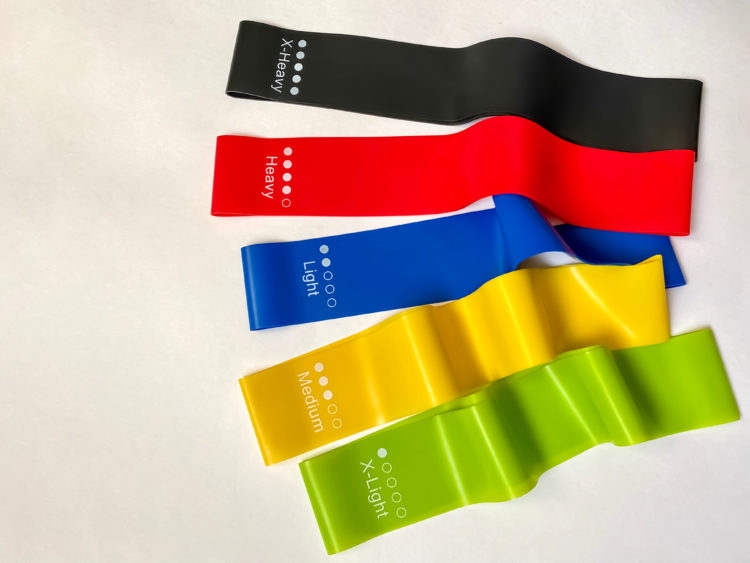4 Mini Band Exercises That'll Give You Stronger and More Stable Hips | BarBend (original) (raw)
When it comes to the hips, the glute max gets all the love. Browsing through Instagram only reinforces this point, since after all, the aesthetics of a firm tush are pretty highly valued. Remember the song ‘Baby Got Back?” It wasn’t called baby’s got hip flexors for a reason. A great pair of glutes starts with the glute max. But there are smaller muscles surrounding the hips that play an important role in their strength and mobility.
And the mini band is a great tool to train these muscles.

Natalia Plekhanova/Shutterstock
What Are Mini Bands?
Mini bands are 9-inch flat bands that are great for targeting the muscles of your thighs and glutes. Mini bands can be added to exercises to give extra resistance (around the knees during a barbell squat) or used by themselves to train the smaller muscles of the hips.
Movements And Muscles Of The Hip Joint
The hip is a ball-and-socket joint: the ball is the femoral head, and the socket is the acetabulum. The hip joint is where the femur and pelvis meet, and then pelvis connects with the bones of the head and trunk of a vertebrate.
Being a deeper ball and socket joint as opposed to the shoulder, it doesn’t have as much freedom of movement, but it’s a stronger joint allowing you to run, jump, sprint and squat.
Here are the main movements and muscles used around the hip-joint
- Hip adduction- adductors (brevis, longus, magnus) gluteus maximus
- Hip abduction- gluteus medius, gluteus minimus
- Hip external rotation- piriformis, psoas major and minor
- Hip internal rotation- tensor fasciae latae, gluteus medius, gluteus minimus
- Hip extension- gluteus maximus, gluteus medius
- Hip hyperextension- gluteus maximus, hamstrings
- Hip flexion- iliacus, psoas major
There’s more to the hips than extension. To fully develop the hip joint it pays to train the other movements to strength and mobilize one of the strongest joints in our body.
Here are 4 exercises to add to your routine pronto.
1 & 2. Hip External And Internal Rotation
The hip needs around 45 degrees of internal (and external) rotation.(1)
And if you don’t have enough internal rotation (or there’s a weakness) compensations include overpronation at the feet, a knee valgus (a big deal when coming out of the hole of the squat), reduced step length and increased lumbar and knee extension.
Furthermore, when you’re supporting your weight on one leg while simultaneously moving your upper body (for example a baseball pitcher or a quarterback is throwing a ball), you’re relying on the hip external rotators.
And if you have any weakness or shortness in your external rotators, it’s difficult to maintain your stability while standing, walking, or extending either of your legs while walking, running or lunging.
This would make single leg exercises suck even more.
Form Tips and Programming Suggestion
- Choose a light band to start with and make sure the movement is coming from your hip and nowhere else.
- These smaller muscles need endurance, so 2-3 sets of 12-15 reps as part of your warmup works well.
[Related: 4 mini band exercises to improve shoulder health]
3. Mini Band Monster Walk
The monster walk trains hip extension in one leg and hip abduction in the other, particularly the muscles of the glute max, meds and mini, which all play an important role in the function and health of your lower back and knees.
Training these builds better hip stability, which is needed for sprinting, running and all the single leg exercises you love to do.
Form Tips and Programming Suggestions
- The lower you place the band, the harder it will be.
- Around the ankles = difficult.
- Above the knees = easier.
- Keep tension in the band and ‘walk’ slowly and deliberately.
- This is best performed as a warmup exercise for 10 steps forwards and backwards or used as filler exercise between squats or deadlifts.
4. Mini Band Hip Flexion Iso Hold
Do you have weak hip flexors? You may feel your hips are tight, but it could also mean your hip flexors are weak. Watch this video so you can tell the difference.
Weak hip flexors lead to problems in the hip joint which include misalignment of the spinal vertebrae and SI joint. Weak hip flexors can also cause tension in the lower back area, which contributes to lower back strains and spinal issues.
Form Tips And Programming suggestion
- The standing hip flexion isometric hold trains single leg balance and hip flexor endurance, which is best trained while you’re fresh.
- Use a light band to start with and have something solid to the side of you in case you lose your balance.
- Hold for 30-60 seconds on each side before you attack your squats, deadlifts or single leg training.
Wrapping Up
Your hips act as a “bridge” from your lower to upper body and vice versa. And if you don’t strengthen the hips in all ranges of motion, you may have problems in the lower and upper body.
Bands are lightweight, cheap, and often used to tone the butt, so some serious athletes tend to roll their eyes at them. But don’t be fooled: they’re absolutely fantastic for lateral strength, injury prevention, and helping maintain form.
Featured image via Zoran Pucarevic/Shutterstock
Reference
- J Phys Ther Sci. 2015 Feb; 27(2): 441–445. Hip rotation range of motion in sitting and prone positions in healthy Japanese adults. Heonsoo Han, RPT, MS,1,* Akira Kubo, RPT, PhD,1 Kazuo Kurosawa, RPT, PhD,1 Shizuka Maruichi, RPT,2 and Hitoshi Maruyama, RPT, PhD1